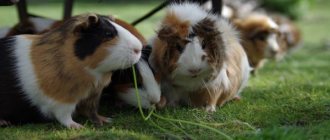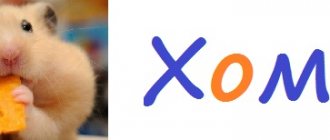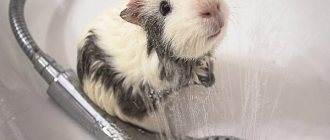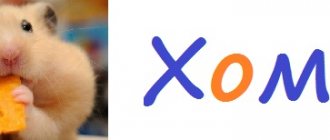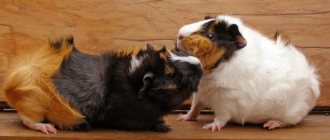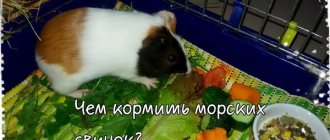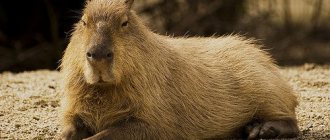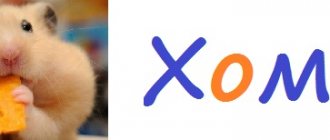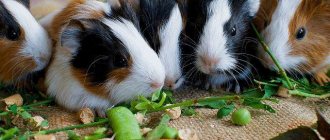Even experienced livestock breeders ask questions: what to feed their pet, whether it is possible to give certain products. Before getting a guinea pig, you should find out which foods will benefit the animal and which may harm its health. A guinea pig's daily menu should include vegetables, fruits, berries and cereals. Many vegetables and fruits can even be offered to your pet along with the peel. It is important to remember that not all foods that guinea pigs eat are equally beneficial for them. What rodents can eat and what they cannot feed a guinea pig is discussed in this article.
Vegetables
Can guinea pigs have radishes?
It is permissible to use only radish tops. The root vegetable contains essential oils that can cause irritation to the mucous membranes and respiratory tract of the animal. The vegetable also causes bloating. Therefore, it is not recommended to give radishes to pigs.
Can guinea pigs eat celery?
Celery can be given in any form - stems, leaves, roots. This vegetable is included in many dry food for rodents. Celery is enriched with vitamins B, PP, E, C, A and contains phosphorus, zinc, potassium, calcium, iron and magnesium. Before eating, celery must be washed thoroughly, especially the root.
Can guinea pigs eat tomatoes?
Ripe fruits can be included in the food. Tomatoes are well absorbed by animals and contain vitamin C and carotene, which are beneficial for their body. Green tomatoes contain solanine, which can negatively affect your pet’s health.
Too many tomatoes in an animal's menu can cause loose stools.
Can guinea pigs eat cabbage?
Cabbage can be included in the animal's diet. Cabbage contains many vitamins and other substances necessary for pigs:
- ascorbic acid;
- B vitamins;
- vitamins of the PP group;
- folic acid;
- sulfur;
- calcium;
- potassium;
- phosphorus;
- amino acids;
- microelements.
Today we have cabbage lunch.
The vegetable is able to keep the animal’s fur in excellent condition and strengthen its immunity. The top dried leaves should be given. It is preferable to feed guinea pigs Chinese cabbage and broccoli. White cabbage can cause bloating.
Can guinea pigs eat potatoes?
Green and sprouted potatoes are contraindicated for guinea pigs. Raw vegetables can be given occasionally, cut into small pieces. Boiled potatoes can be offered to your pet separately or added to grains and other foods.
The vegetable contains solanine, which can harm the health of the animal if the pet eats too many potatoes. The pig will become passive and catch cold quickly.
Can guinea pigs eat beets?
Beetroot contains many substances useful for animals: vitamins C, A and B, potassium, magnesium, phosphorus, iron. In excess, the vegetable contains fiber, so it acts on the animal’s body as a laxative. Store-bought root vegetables may contain nitrates, which are very harmful to the small body of guinea pigs. It is better to offer your pet homemade crops. The composition also contains a large amount of oxalic acid, so it is better to limit the consumption of this product.
It is recommended to give beets starting from 2 months; they are especially useful in winter and spring, when there are no fresh vegetables. The daily dose should not exceed 200 g, and it is better to exclude beets from the diet of pregnant and lactating pigs so as not to provoke an upset stomach. Beets turn stool and urine red, so if your animal has eaten them, don’t be alarmed by such changes.
Can guinea pigs eat pumpkin?
Pigs can be given all varieties of pumpkin that humans eat. For the digestion of herbivorous animals, such a product will be familiar and useful. Pumpkin contains vitamin C, calcium and phosphorus necessary for rodents. It should be borne in mind that this low-calorie vegetable will not be able to saturate the pig completely, so it is better to give pumpkin to guinea pigs as a treat.
Can guinea pigs eat bell pepper?
Another storehouse of ascorbic acid is bell pepper. Before use, the vegetable must be thoroughly washed and chopped, and the seeds removed. It is better to give the product together with dry food.
Green peppers containing solanine should not be given to animals, as should peppers in the form of hot seasonings. Spicy foods will damage the mucous membranes.
Can guinea pigs eat cucumber?
Cucumbers don't have as many nutrients as other vegetables. You can offer your pet a cucumber. The vegetable can harm your pet's health by causing digestive problems only if consumed in large quantities.
Can guinea pigs eat zucchini?
Zucchini is suitable for the diet of guinea pigs. They contain small amounts of vitamin C, calcium and phosphorus. It is better to prefer young vegetables; they can be given along with the peel, cut into crowbars.
Potato
But whether guinea pigs can have potatoes is of interest to most guinea pig breeders. Potatoes contain a large amount of starch, proteins, and vitamins. It is not recommended to give potatoes to guinea pigs. Raw potatoes contain starch that is difficult to digest, so if you decide to give your pet potatoes, give them a very small amount. Green tubers, green sprouts and potato tops contain a lot of poisonous solanine. Therefore, tubers that have turned green and have been stored for a long time should not be fed.
Fruits and berries
Bananas
Can guinea pigs have bananas? A banana rich in potassium will benefit your guinea pig, but you should not give more than 1 piece per day.
The peel of the vegetable must be removed, as it is treated with substances hazardous to health (wax, chemicals, ethylene and pesticides). For safety, it is better to remove soft fibers from the fruit.
I'm eating a banana! Om-Nom-nom. I won't give it to you!
Can guinea pigs eat a pear?
Pears can be given with the peel, but without the seeds. The fruit is washed well and cut into pieces; the pig should be offered water along with it. Excessive consumption of pears due to their high sugar content can cause diarrhea.
Can guinea pigs eat kiwi?
Kiwi is a very healthy fruit for animals. It contains a large amount of ascorbic and folic acids. It is also rich in vitamins E, iron, calcium, magnesium and phosphorus.
Kiwi is given without skin in the form of small pieces. For your pet, you need to choose harder fruits. It is better to control the amount you eat. An increase in the dose of kiwi is permissible in autumn and winter, as well as when feeding females during pregnancy and lactation.
Can guinea pigs have oranges and other citrus fruits?
Can be used occasionally. But it is better for guinea pigs to get vitamin C from other foods, avoiding citrus fruits. Possible complications:
- oversaturation with vitamins;
- skin irritation;
- oxidation of urine.
Can guinea pigs eat apples?
Apples can be raw or dried. They have a balanced ratio of sugar and fructose (18:80%). It allows the pig to be active.
The fruit must be peeled and cut into slices. It is better not to give more than 3 pieces at a time.
Can guinea pigs eat strawberries, grapes and other berries?
Strawberries contain a sufficient amount of vitamin C to pay attention to the berry when choosing a treat for a rodent. You can also give strawberry leaves to animals.
- The pig might like grapes. You can offer the animal seedless grapes.
- Eating currants once a week will also not harm your pet.
- If you do not abuse it, you can offer the pig berries and raspberry leaves, berries, leaves and branches of blueberries, blackberries and sea buckthorn, and rose hips without seeds.
- Cranberries are given for medicinal purposes. It has an anti-inflammatory effect on the mucous membranes of the mouth, stomach, and bladder.
Watermelon
Guinea pigs can be given a little watermelon during the summer season. Try to give ripe pulp, and it is advisable not to give the white part closer to the rind, since it is in this part that nitrates accumulate. For the same reason, pigs should not be given early vegetables. Watermelon is a diuretic, so indulge your pet with it infrequently.
Dairy
Can guinea pigs have milk?
Giving milk to guinea pigs is not recommended. The enzyme that is responsible for the breakdown of milk sugar (lactose) is found in insufficient quantities in the body of animals. If your pig drinks milk, the lactose will cause diarrhea and bloating. More serious diseases may develop in the future, so it is better to show your pet to a doctor.
Females can and even need to be given milk during lactation. You can soak crackers in milk and offer them to your pig.
The ban also applies to other dairy products: cottage cheese, cheese, yogurt and others.
Carrot
Carrots are a very healthy vegetable containing pectin, carotene, vitamins C, E, K, group B, and microelements. The substances contained in carrots have a beneficial effect on metabolic processes in the pig’s body, thereby improving the pet’s vision, hearing, and condition of the skin and coat. You can also feed carrot tops, which are also useful. Eating this vegetable may cause your pet's urine to turn orange.
Other products
Bread
Can guinea pigs eat bread? It's better not to give.
- Fresh yeast bread takes a long time to digest and causes fermentation in the animal’s stomach.
- White bread causes bloating.
- Your pet can eat stale bread, but not often.
- Dried bread with seeds, sesame seeds and raisins can sometimes be offered to your pet as a treat.
Can guinea pigs eat nuts and seeds?
Nuts and seeds are among the allowed foods, but can cause obesity if their consumption is not limited. It is better to offer your pet almonds, walnuts or hazelnuts.
The seeds contain many components useful for the animal: fatty acids, calcium, sodium, phosphorus, proteins and vitamins. It is better to give peeled seeds and make sure that they are no more than 15% of the total feed.
Jerusalem artichoke
The entire Jerusalem artichoke plant, leaves, flowers, roots, is edible for guinea pigs. Jerusalem artichoke contains a large amount of fiber and essential amino acids - lysine, leicine, arginine. Root vegetables contain inulin, a natural analogue of insulin, which is why Jerusalem artichoke is recommended for those prone to diabetes. But root vegetables should not be given to marine animals often, since they are considered concentrated feed, and young tubers contain poorly digestible starch, which can cause intestinal disorders.
Cucumber
Enriched with liquid, vitamins and potassium, cucumber is definitely suitable for feeding a rodent. This means it can be given to guinea pigs. These animals simply adore its juicy taste, crispy texture and pleasant smell. In the summer season, it is worth introducing into the diet only vegetables grown in a familiar source. However, store-bought copies can be thoroughly cleaned under running water. In winter, you should refrain from feeding cucumbers due to the high nitrate content. The human body is able to withstand an acceptable dose, but the small body of an animal will be severely poisoned, perhaps even with a disastrous outcome.
The permissible dose of cucumber for a guinea pig is ¼ of a small fruit, cut into small slices.
Basic nutrition
Guinea pigs are herbivores. In nature, they eat mainly fresh vegetation and dry grass - hay (needed to support the digestion process). Less often - berries and fruits. Almost never – nuts and grains. This makes them very different from other domestic rodents, which can be fed with a cereal mixture.
Simply buying dry food for rodents and feeding them only will not work. It contains too many grains (read: carbohydrates). From excess carbohydrates, your pet quickly gains weight and loses mobility. In particularly difficult cases, the gastrointestinal tract stops or diabetes develops.
Among professional cavy breeders, there are two approaches to feeding guinea pigs: feed exclusively fresh food or with the addition of dry mixtures. In the latter case, the ratio of products in the diet will look something like this:
- Hay (preferably from legumes) – 50%
- Dry food (store-bought or home-prepared) – 20%
- Juicy food (fresh vegetables and fruits) – 20%
- Fresh grass – 10%
If you decide to go grain-free, feed succulent food instead of dry food (replace dry food with succulent food on the list). However, keep in mind that fresh vegetables and herbs will have to be given to the rodent even in the harsh winter.
To make it easier for you to create a menu for your guinea pig, we have compiled a nutrition chart (located below) that shows what you can feed your guinea pigs at home and what you cannot feed them. But if you want to know why cavy eat one thing and not another, when and how to feed them, how to choose food, be sure to read the article to the end.
The right balance of nutrition is the key to health and long life.
In what form should it be offered?
All vegetables are offered to the animal only fresh. Salted, pickled, canned fruit is harmful food for your pet. Any pickles and preserves contain sugar, vinegar, spices and a large amount of salt. These spices are not allowed on the menu of a tiny animal.
A high-quality harvest from the garden will improve your pet’s diet, making it healthy and varied.
What else can you pamper your pet from your own garden? Read about this in the following articles: “Can a guinea pig eat peas and corn?” and “Can guinea pigs have apples and pears?”
Source
Vegetable menu
Pigs have to look for vitamin C, which is responsible for the functioning of connective and bone tissues, from the outside, since their body is not able to produce it on its own.
Guinea pigs love apples, cucumbers and carrots.
Ascorbic acid enters the body from plant foods, including fresh vegetables (broccoli, bell pepper), amounting to at least 1 teaspoon per day.
Vegetables that can be given to guinea pigs include:
- Zucchini
. Rich in vitamins, minerals and pectins, which normalize intestinal motility. - Carrot
. Positively affects the condition of the skin and coat, visual and auditory functions. In addition to root vegetables, it is allowed to feed tops. The beta-keratin (vitamin A) content gives urine an orange tint. - Bell pepper
. Rich in vitamin C, but dangerous in winter due to the amount of harmful nitrates. Only sweet varieties are allowed as food, while spicy ones lead to irritation of the mucous membranes. - Pumpkin
. Not only the pulp is eaten, but also the crust and seeds, which are rich in zinc and act as a prophylactic against helminthiases. - Cucumbers
. Low in calories, have an anti-inflammatory effect and facilitate the absorption of fats. Not suitable as a main food and dangerous in winter (high nitrate content). - Fresh peas
. It is recommended to feed your pets only fresh pods, without overusing the quantity. Dried grains should not be consumed, but some manufacturers add them to ready-made food. - Cabbage
. Requires competent control. It is introduced gradually to avoid excessive gas formation. Rich in sulfur, which synthesizes collagen and adds shine to the coat. - Rutabaga
. Helps with constipation, facilitating peristalsis, and has a diuretic effect. Recommended for use in winter, when the choice of vegetables becomes limited. - Jerusalem artichoke
. The consumption of root vegetables enriched with starches should be limited to avoid intestinal disorders. The remaining parts, rich in fiber and amino acids, are allowed on an ongoing basis.
Controversial and dangerous vegetables include:
- Tomatoes
. In their green (unripe) form they are considered poisonous due to solanine; consumption of the tops is also not recommended. Ripe tomatoes, containing a large amount of vitamins, undergo destruction by dangerous poison, so they can be included in the diet in limited quantities. Avoid tomato abundance, which provokes intestinal upset. - Potato
. Another vegetable rich in poisonous solanine and starchy substances. - Melon
. Dangerous for the development of diabetes due to the abundance of sugars. - Radish and radish
. Essential oils irritate the mucous membranes and cause bloating. - Beetroot
. Has a laxative effect. Not recommended during pregnancy, lactation and age. Feeding fruit to a guinea pig is strictly dosed.
Fruits are rich in sugars, so they are not considered as a complete part of the diet, but exclusively as a delicacy.
Among all the abundance of fruits, only apples can be consumed by a guinea pig without strict restrictions. They normalize digestive processes and remove toxins. The seeds must be removed as they contain toxic toxins.
The following berries are allowed to be consumed:
- Grapes
. The abundance of fiber and vitamin B has a positive effect on the body. Thanks to their pleasant taste, the animal eats berries with great pleasure. - Arbuzov
. Only the pulp is fed to the animals. Crusts accumulate nitrites and are considered dangerous. Due to the diuretic effect, the amount eaten is kept to a minimum. - Rowan berries
. Chokeberry replenishes vitamins C and P, and red chokeberry replenishes carotene.
Controversial and dangerous berries and fruits include:
- Citrus fruits
. Irritate mucous membranes and provoke allergic reactions. - Strawberries
. It is fraught with an excess of vitamin C, leading to allergies, diarrhea, gastritis and ulcers. It is given in tiny doses no more than 1-2 times a week. - Bananas
. They replenish glucose and fiber, but due to the increased calorie content and sugars they are consumed to a minimum.
IMPORTANT! When preparing your diet, please note that marine rodents are herbivores. Meat and dairy products are not digested by their bodies and pose a serious danger
Apple pits must be removed
Melon
The same goes for melon. This vegetable is given from your own garden or purchased in season. It is also not recommended to give melon frequently; it is very sweet and can contribute to the development of diabetes.
We tried to consider in as much detail as possible and give answers to the question “What vegetables can guinea pigs eat?” As you can see, most vegetables are not only possible, but also should be given to guinea pigs. The most important thing is a properly formulated and balanced diet for your pet, including products grown without chemicals. To keep your guinea pig healthy and cheerful, stick to proper nutrition and your pet will thank you with its playful behavior and healthy appearance.
So, we have dealt with the question of what vegetables can guinea pigs eat, but we described in this article whether your pet can eat grass. You may be interested in this information.
Did you like the article? Share with friends: [supsystic-social-sharing id=”1"]
- Related Posts
- Features of behavior and maintenance of guinea pigs
- What fruits and berries can guinea pigs eat?
- Guinea pig hammock
« Previous entry
Concentrates
These are high-calorie foods. They contain a lot of protein and carbohydrates. This group of feeds includes grains, legumes and seeds. This category also includes prepared foods. Products based on herbal flour are especially well eaten. Adult animals should be given approximately twenty grams per day. Lactating and pregnant females, as well as young individuals, need more (about forty grams each).
Cabbage
Can guinea pigs eat cabbage? There is an opinion that cabbage is contraindicated for guinea pigs, that this vegetable causes problems with the digestive system. In fact, cabbage is a healthy vegetable containing a lot of protein, vitamins and microelements.
If you have a healthy pet, not prone to bloating, and you gradually and in small quantities introduce cabbage and other succulent foods into the diet, then your guinea pig will not have problems with digestion. And if you do not follow your pet’s diet and immediately introduce new foods without accustoming your pig to them, then problems with the intestines cannot be avoided. Small amounts of cabbage, cauliflower, Brussels sprouts, broccoli and kohlrabi can be fed infrequently. Do not feed early, greenhouse cabbage.
About the benefits of succulent feed
Nettle
Common stinging nettle has a number of beneficial properties and vitamins. It contains a lot of vitamin C, carotene, B vitamins and carotene. Fresh or dried nettle is a good natural vitamin concentrate. Young nettle leaves are also rich in protein, starch, chlorophyll, carbohydrates and iron salts, potassium and copper, manganese and titanium, nickel, many types of tannins and organic acids. Another advantage of nettle is that it is nutritious. Nettle leaves and shoots contain a large amount of proteins, fiber, and fats.
The leaves can be fed whole, or they can be made into powder and added to the main grain or concentrated feed. It is best to harvest nettles before flowering begins. Young shoots are mowed or only leaves are collected. Dry without pre-washing in a well-ventilated area, but out of direct sunlight.
Dandelion
This common and familiar plant is very useful for guinea pigs and in the summer it must be included in the animal’s diet. The leaves and roots of the plant are fed. Dandelion leaves are very rich in carotenoids, vitamin C, vitamins B and P. Dandelion leaves are good to use to improve digestion in animals, as well as to increase appetite. Dandelion roots are rich in sugar, inulin, and malic acid.
Spinach
Young spinach leaves are suitable for feeding. Spinach is also a source of large amounts of vitamins and proteins, iron salts, calcium and phosphorus. Just one hundred grams of spinach contains more than 700 mg of potassium.
Spinach can be fed not only fresh, but also dried and even frozen.
Cabbage
Headed cabbage is suitable for feeding fresh. Red cabbage is considered more nutritious and rich in vitamins. White and red cabbage is rich in vitamins C, carotene, B vitamins and iodine, pantothenic acid and many salts important for animal health. However, do not forget that cabbage leaves cause fermentation and gas formation in the intestines, so it is not recommended to feed a lot of cabbage leaves per day. Brussels sprouts can also be used to feed guinea pigs. It is rich in ascorbic acid, proteins, carotene, vitamins and salts of sodium, phosphorus and iron, as well as iodine and potassium.
Broccoli is also suitable for feeding. This type of cabbage is nutritious and high in sugar, carotenes, choline, and methionine. Broccoli is very rich in calcium. A big plus of broccoli is that it can be frozen and fed even in winter.
Lettuce leaves
Lettuce is a favorite food of guinea pigs. Regular leaf lettuce sprouts quite quickly and forms rosettes, so many breeders even grow it in pots at home. Lettuce leaves are rich in sugar and metals important for the guinea pig’s body:
Lettuce leaves contain almost all known vitamins and folic acid. Regular feeding of lettuce helps improve digestion and has a good effect on the pig's metabolism and appearance.
Parsley and dill
Our usual parsley and dill are high in vitamin C and carotene. Dill is especially recommended for guinea pigs during pregnancy and nursing. Dill not only increases milk production, but also improves the nutritional quality of milk. It is recommended to feed parsley to young animals and guinea pigs during the molting period, as well as after illness.
What are the consequences of violating the nutritional rules?
According to statistics, pigs most often die due to intestinal disorders. With improper feeding, the microbial balance in the digestive tube is disrupted, the breakdown of cellulose is difficult, food is not properly digested, and death occurs from intoxication with metabolic products
This is why it is so important to monitor your diet and feeding regimen.
Feed must be of good quality and fresh, it must smell good and have no signs of spoilage or mold damage.
It is important that products are stored in places inaccessible to insects and wild rodents - carriers of dangerous diseases
Healthy Supplements
The most common dietary supplement is vitamin C, which is diluted in drinks. It is not produced in the body on its own, but if the basic feeding rules are followed, guinea pigs receive it in sufficient quantities from fresh vegetables and feed mixtures. Vitamin C can be used as a supplement only as prescribed by a ratologist; usually such a need arises if we are talking about a weakened stomach or a prolonged period of artificial feeding.
The guinea pig is a herbiphorus, which means “herbivore,” and has a relatively long digestive tract specially adapted for digesting coarse fibers.
Therefore, it is important that the pigs’ food contains a lot of plant fiber (fiber). Good hay is a very important element in nutrition
It contains a large amount of fiber (fiber), which plays an important role in the digestive process.
Guinea pigs need good food, preferably as varied as possible. The diet of guinea pigs consists of roughage (solid) food (mostly hay), green food (grass, leaves) and succulent food (vegetables and fruits). The latter is not at all necessary in the diet, but is very convenient to use.
How to determine the age of a guinea pig?
Please note: examine only the claws of the hind paws - behind the front paws
takes care of them, so they almost always look good.
On the hind legs of an old pig, the claws are ground down and may be bent. All this is evidence of age-related changes. With good care, a guinea pig
can live more than 10 years.
Interesting materials:
How much does Creon cost 10,000 units? How much does a cubic meter of gas cost in Evpatoria? How much does a cubic meter of gas cost in Feodosia? How much is the 2 dollar bill of 2013 worth? How much does Laktazar cost? How much does Duphalac cost? How much does Creon medicine cost? How much does Lyoton gel cost? How much does a liter of gasoline cost in Canada? How much does Logitech g102 cost?

